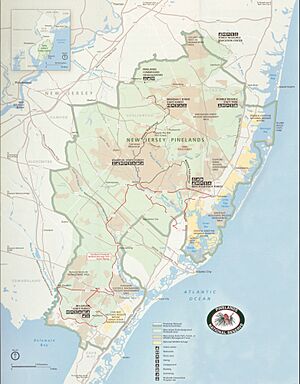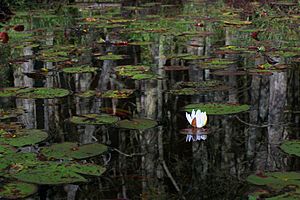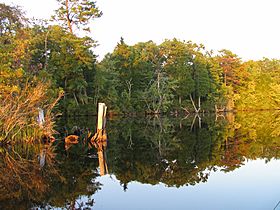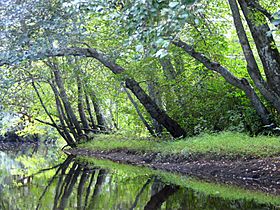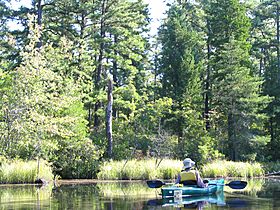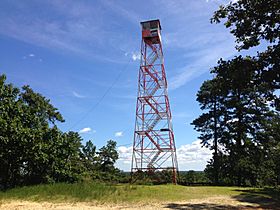Pine Barrens (New Jersey) facts for kids

The New Jersey Pine Barrens, also called the Pinelands or just the Pines, is a huge natural area in New Jersey. It's the biggest example of a special type of forest called the Atlantic coastal pine barrens ecosystem. This area covers more than seven counties in the state. The name "pine barrens" comes from its sandy, acidic soil, which isn't good for growing many common crops. But this unique soil helps many special plants grow, including orchids and carnivorous plants! You can also find rare pygmy pitch pines here. These plants actually need the frequent fires in the Pine Barrens to grow and spread their seeds. Locals call the sandy soil "sugar sand".
Even though it's close to big cities like Philadelphia and New York City, the Pine Barrens is mostly rural and peaceful. It's right in the middle of the busy Boston-Washington Corridor on the Eastern Seaboard. Important roads like the Garden State Parkway and Atlantic City Expressway go through parts of it. The Pine Barrens is also very important because it helps refill the huge 17 trillion-gallon Kirkwood-Cohansey aquifer underground. This aquifer holds some of the purest water in the United States. Because of all these reasons, the U.S. Congress decided to protect the Pine Barrens in 1978. They made about 1.1 million acres (4,500 km²) of it the Pinelands National Reserve. This was the first National Reserve in the country! Later, the United Nations named it an International Biosphere Reserve. A group called the New Jersey Pinelands Commission carefully controls any building or development in this protected area.
The Pinelands Reserve includes several state forests like Wharton, Brendan T. Byrne, Penn, and Bass River. It also has two rivers, the Maurice and the Great Egg Harbor, which are part of the National Wild and Scenic Rivers System. A famous book from 1967 by John McPhee, called The Pine Barrens, tells the story and explains the nature of this special region.
Contents
History of the Pine Barrens
Ancient Times
The land that became the Pine Barrens started forming a very long time ago, between 170 and 200 million years ago. The area we see today was shaped over millions of years as the coastline rose and fell, leaving minerals underground. This process finished about 12,000 years ago, after the last ice age, when plants and trees began to grow in New Jersey.
Forest fires have always been a natural part of the Pine Barrens. Fire has played a huge role in shaping the plants and trees here for thousands of years.
Native American History
About 10,000 years ago, the ancestors of the Lenape people were the first humans to live in the Pine Barrens.
The Lenape tribes would burn parts of the woods in the spring and fall. This helped clear out thick bushes, made it easier to find food, and improved hunting conditions. The sandy soil of the Pine Barrens wasn't good for farming, so people didn't settle there permanently to grow crops. This meant that people often set fires for their own benefit, even on land that belonged to others. For example, people who made charcoal would sometimes set fires on purpose. This made the trees only useful for charcoal, so they could buy them cheaply.
European Settlers and Industries
In the 1600s, explorers and settlers from Sweden and the Netherlands came to New Jersey. They built fishing villages along the Delaware River. England later claimed the area in 1664.
The first shipbuilding businesses started in the Pine Barrens in 1688. They used local cedar, oak, and pitch trees, along with tar and turpentine. Around 1700, the first sawmills and gristmills opened, leading to the first European settlements in the Pinelands.
During the time of the American colonies, many industries grew in the Pine Barrens. In 1740, people started making charcoal here. The first iron furnace opened in 1765. Workers dug up "Bog iron" from bogs, streams, and rivers. This iron was used in about 35 furnaces, including places like Batsto and Lake Atsion. The iron made here was very important for making weapons and tools for the American military during the American Revolution and other early wars. For example, cannons used by Commodore Stephen Decatur Jr. in 1814 were made at Hanover Furnace.
In 1758, the first Indian reservation in the Americas was created at Brotherton, which is now Indian Mills. During the Revolutionary War in 1778, the British attacked a village called Chestnut Neck. They tried to destroy the ironworks at Batsto Village, but they failed. After the war, the first glassworks opened in Port Elizabeth in 1799. By then, whaling had stopped. The first cotton mill in the Pine Barrens opened in 1810.
People started growing cranberry bogs in the 1830s. In 1832, the first paper mill opened. In 1854, the first railroad was built across the Pinelands, connecting Camden to the new city of Atlantic City. Soon, railroads linked many small towns throughout the Pine Barrens.
The bog iron industry ended in 1869 because it became cheaper to mine iron in Pennsylvania. Other industries like paper mills and sawmills also came and went. Over time, the forest grew back and covered most signs of these old industries. You can still find Ghost towns, which are the remains of villages built around these old businesses. Batsto Village has been restored to look like it did in the mid-1800s and is now a historical site.
The "Pineys" and Preservation Efforts
For many years, people from outside the Pine Barrens used the term "Pineys" to describe the rural families living there. It was often used in a negative way. However, today, many people who live in the Pinelands are proud of this name and their connection to the land.
In the early 1900s, a study was done on a family from the Pine Barrens, using the fake name "Kallikaks". This study wrongly tried to show that some families were naturally less intelligent. We now know that the facts in this study were twisted, and even some photos were changed to make the family look less intelligent.
Even though areas around it were quickly becoming cities, the Pine Barrens stayed mostly untouched. Its sandy soil wasn't good for most crops, and its iron and charcoal weren't as easy to get as in other places. In 1969, the Pine Barrens had only about 15 people per square mile, while nearby areas had 1000 people per square mile!
People became worried that the Pine Barrens and its important underground water supply would be destroyed by too much building. There were even plans to build a huge airport and a new city in the Pine Barrens. But thankfully, in 1978, the U.S. Congress created the New Jersey Pinelands National Reserve. This was done to protect this special area. The Pinelands was also named a U.S. Biosphere Reserve by UNESCO in 1983 and an International Biosphere Reserve in 1988. A person named Howard P. Boyd worked hard to protect the Pine Barrens and teach people about it.
The Pine Barrens is also famous for many legends and tales.
The Jersey Devil Legend
One of the most famous legends from the Pine Barrens is about the Jersey Devil. The story says that in 1735, a local woman named Mrs. Leeds gave birth to her 13th child in an area called "Leeds Point". Because it was her 13th child, some say it was cursed. Another version of the story says she gave birth to a scary monster that attacked her and her nurses. Then, it flew up the chimney and disappeared into the Barrens. Most stories of people seeing the legendary Devil have happened in or near the Pine Barrens.
Geography of the Pinelands
The New Jersey Pinelands National Reserve covers about 1.1 million acres (4,500 km²) of land. This is about 22% of all the land in New Jersey! It includes parts of seven counties: Atlantic, Burlington, Camden, Cape May, Cumberland, Gloucester and Ocean.
The Pine Barrens is a big part of the Atlantic coastal pine barrens ecoregion, which is a unique type of natural area. The forest is always at risk from new buildings and development in the surrounding areas. While some fires happen naturally, most fires in the Pine Barrens are started by humans.
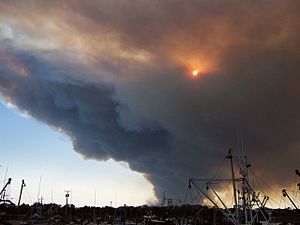
Climate in the Pine Barrens
The Pine Barrens of New Jersey are in a special climate zone. It's a mix between a humid subtropical climate (like the southern U.S.) and a humid continental climate (like the northern U.S.).
The Pine Barrens has its own "microclimate." This means it has a shorter time without frost and colder nights compared to most of New Jersey. Because of the sandy soil and not many buildings, clear and calm nights can get much colder here than in nearby areas. On an average night, it can be 6 to 8 degrees Fahrenheit colder, and sometimes even 10 degrees colder!
The Pine Barrens gets snow every year, usually between 15 to 21 inches. The northern parts get the most snow. Summers are usually hot and humid, and winters are cold. Spring and fall are milder. You can see frost in the fall, spring, and winter. Frost happens earlier in the fall and later in the spring in the Pine Barrens because of the sandy soil.
The average rainfall in the Pinelands is about 42 to 46 inches per year, but the amount of rain can change a lot from year to year. Thunderstorms are common in the warmer months, bringing strong winds and heavy rains.
Flora: Plants of the Pine Barrens
The Pine Barrens is home to at least 850 different kinds of plants! About 92 of these plants are considered threatened or endangered. Several types of orchids, including the beautiful Pink Lady's Slipper, grow naturally here.
Fires have a strong effect on the types of forests you see. Where fires happen often, you might find "dwarf pine forests" that are less than 4 feet (120 cm) tall. In places where fires are rare, you'll see more oak forests. Along the rivers and waterways, you can find dark swamps of Atlantic white cedar trees.
Forest fires are very important for the plants in the Pine Barrens. Frequent, small fires help reduce thick bushes and let mature trees grow. Fires also help pitch pine trees grow well. These trees are special because they can survive fires and grow back quickly, even through their bark! Their pine cones are "serotinous", which means they only open and release their seeds after being heated by a fire. Because of these fires, pitch pines are more common than oak trees. Oak trees are usually killed by a strong fire.
There's a lot of discussion about how to best protect the Pine Barrens when it comes to fighting fires. While fires can be dangerous to homes, many people who want to preserve the area argue that stopping all fires would cause oak trees to take over. In some areas where fires have been stopped, oak trees have indeed become more common than the scrub and pitch pines that used to be there.
Fauna: Animals of the Pine Barrens
The Pine Barrens is home to many different animals! You can find at least 39 kinds of mammals, over 300 types of birds, 59 reptile and amphibian species, and 91 kinds of fish. At least 43 species are considered threatened or endangered by the NJ Division of Fish and Wildlife. These include the rare eastern timber rattlesnakes and bald eagles.
A special and threatened frog, the Pine Barrens tree frog, lives here. American black bears are also starting to return to the Pine Barrens after being hunted out of the area a long time ago.
The bobcat was thought to be gone from New Jersey by 1970 because of habitat loss. But it was protected by law in 1972. Between 1978 and 1982, 24 bobcats were brought from Maine to the northern part of the state. Since 1996, scientists have been tracking them with GPS devices to learn where they live. Bobcats have been seen in several counties that include or are near the Pine Barrens, like Atlantic, Burlington, Cape May, Cumberland, Ocean, and Salem counties.
Economy: What People Do Here
The main jobs and businesses in the Pine Barrens are related to farming and tourism.
Agriculture: Farming in the Pines
New Jersey is the third-biggest producer of cranberries in the country. Most of these cranberries are grown in areas around Chatsworth, including Whitesbog. The first cultivated blueberries were grown in the Pine Barrens in 1916. This happened thanks to the work of Elizabeth Coleman White at Whitesbog. Today, blueberry farms are almost as common as cranberry bogs in the area. Most blueberry farms are found near the town of Hammonton.
In Popular Culture
The Pine Barrens has appeared in books and TV shows.
- An episode of the TV show The Sopranos is called "Pine Barrens" and is set there. However, the episode was actually filmed in Harriman State Park in New York, not in New Jersey.
- John McPhee's book, The Pine Barrens (1968), explores the history, nature, and geography of the New Jersey Pine Barrens. His book helped people understand how important pine barrens are for protecting underground water supplies.
- The 2013 horror novel Call of the Jersey Devil by Aurelio Voltaire is also set in the New Jersey Pine Barrens.
- Survival expert Tom Brown Jr.'s autobiography, The Tracker, describes how he learned his survival skills in the Pine Barrens.
Gallery
-
Kayaking on the Mullica River
-
Fire tower on Apple Pie Hill
Images for kids
-
View north from a fire tower on Apple Pie Hill in Wharton State Forest, the highest point in the New Jersey Pine Barrens


